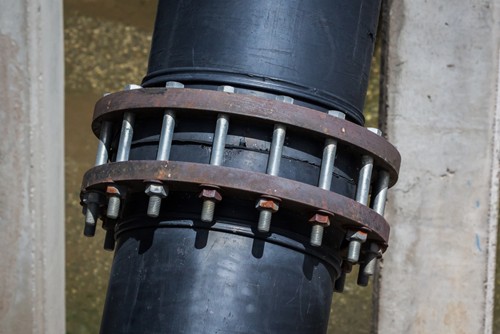Shell and tube heat exchangers are integral pieces in a processing operation and must be fully operational at all times. However, there are a number of things that can go wrong when operating such highly pressurized equipment – such as leaks.
Leaks are never OK in process equipment. Depending on the exchanger, where it is and what it’s used for, leaks can decrease productivity; impact a company’s bottom line; contaminate product or heat transfer fluid; create a safety or environmental hazard; or increase the risk of fire. As such, any leakage from a shell and tube heat exchanger must be addressed soon after it’s detected.
One common area equipment operators observe leakage is around the flanges of a shell and tube heat exchanger. Flanges have three main components: a ring, a gasket and bolts to hold the flange together and secure it to the exchanger. When a flange leak occurs, it’s typically associated with the gasket – perhaps it’s not installed correctly or the wrong size is used – but that’s not always the case.
When leaks happen, it’s important to identify them quickly, then determine the cause. Here are several possible causes of flange leaks in shell and tube heat exchangers:
Thermal stress causing distortion
The temperatures of product inside a shell and tube heat exchanger can vary dramatically; that was, after all, what the exchanger was designed for. However, distortion caused by the rapid change from hot to cool solutions is inevitable in some cases. If this is the case, it’s important to ensure all parts of the exchanger are designed to account for temperature distortion.
“Take temperature fluctuations into account during the design phase to prevent future leaks.”
Writing for Chemical Engineering Magazine, mechanical design engineer Pankaj Kumar Singla pointed out that American Petroleum Institute standard 660 outlines temperature limits and when they become a major factor to consider when designing shell and tube heat exchanger flanges; however, these standards are only a guideline. There are cases when an operation should take temperature fluctuations into account during the design phase, even when they have not met API 660.
To determine if special consideration should be made regarding the flanges, Singla suggested first determining the temperature inlet and outlet for the tube side. Next, determine the temperature for a random area within the tube as well as a random area on the shell side. Then, calculate the difference between the tubeside inlet and outlet as well as the difference between the random area on the tubeside and that of the shellside. If either equation results in a temperature differential of more than 110 degrees Celsius, be sure to take this into account.
Singla noted several strategies and design adaptations that may be beneficial in these cases:
- Increasing the thickness of the flange and tubesheet.
- Reduce the allowable flange rigidity index.
- Reduce the allowable stresses for flanges and tubesheets.
- Make the required bolt ratio 120 percent of design and perform full bolt-load calculations.
The bolts aren’t secure anymore
When your exchanger is in operation, there may be vibrations, temperature increases and high pressure, all of which can affect the security of your bolts. Over time, the bolts may loosen and cause the gasket to leak. Of course, the obvious answer is to tighten the bolts again and proceed with your operations. However, it’s important to consider the method by which you tighten the bolts, as well as how often you need to tighten them.
Torquing is the typical method of tightening bolts when they become loose. Dennis Martens and Michael Porter wrote for Penn State that hot torquing and hydraulic tensioning are two methods that can be more effective in tightening bolts and keeping them secure.
If you find that you’re tightening your bolts continuously with seemingly no effect on leakage, there could be another factor at play. The American Society of Mechanical Engineers pointed out that, when equipment has excessive paint over or around the bolts, this could reduce the bolt integrity. As the paint degrades, it can reduce the bolt load and cause leaks to occur, for example.
Other times, the design of the shell and tube heat exchanger simply isn’t adequate for the stress within, and an addition to the equipment may be required to mitigate the problem.
Additional hardware is needed
Martens and Porter discussed in their report “Investigation and Repair of Heat Exchanger Flange Leak” a recurring problem in a shell and tube heat exchanger, whose bolts never seemed to stay secure, despite efforts to tighten them using proven techniques. Even after hot torquing and hydraulic tensioning, the bolts would loosen and cause problematic leaking in the plant.
The researchers identified two problems: excessive bolt load and gasket scuffing. The excessive bolt load was caused by the temperature differential. To combat this issue, disc spring washers were installed before replacing the bolts. They found that these were more capable in handling the load to the bolts without allowing flange deformation.
The second issue of gasket scuffing was likely due to movement during operation and caused enough damage to the gasket that, even with adequate bolt tightness, it would continue to leak. The gasket needed to be replaced, but the problem also needed to be addressed so the new gasket would not also fall into disrepair. To avoid this, a weld ring, which consists of two separate halves of the gasket ring being welded together to contain the gasket material and prevent deformation. This creates a sealed gasket.
If you’re experiencing gasket leaks in your shell and tube heat exchangers, it could be an indication that something is amiss in your equipment. The engineers at Enerquip are happy to help you get to the bottom of the problem and help devise a solution for your process equipment.

